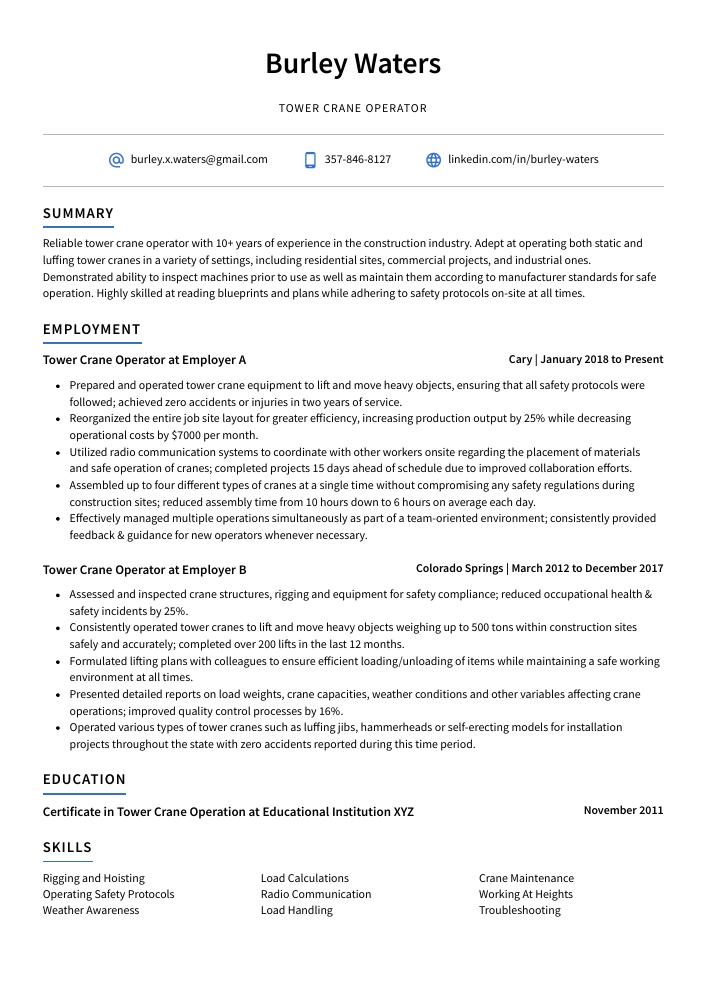Tower Crane Operator Resume Guide
Tower crane operators operate and maintain tower cranes to lift, move, and position machinery, equipment, and other large materials at construction sites. They ensure the safety of workers in the vicinity by following all established protocols while operating the crane. Additionally, they inspect the crane on a daily basis to identify any potential issues or malfunctions that may interfere with its operation.
You have experience operating some of the most complex tower cranes in the industry, but no one knows it yet. To introduce yourself to potential employers, you must create a resume that highlights your qualifications and expertise.
This guide will walk you through the entire process of creating a top-notch resume. We first show you a complete example and then break down what each resume section should look like.
Table of Contents
The guide is divided into sections for your convenience. You can read it from beginning to end or use the table of contents below to jump to a specific part.
Tower Crane Operator Resume Sample
Burley Waters
Tower Crane Operator
burley.x.waters@gmail.com
357-846-8127
linkedin.com/in/burley-waters
Summary
Reliable tower crane operator with 10+ years of experience in the construction industry. Adept at operating both static and luffing tower cranes in a variety of settings, including residential sites, commercial projects, and industrial ones. Demonstrated ability to inspect machines prior to use as well as maintain them according to manufacturer standards for safe operation. Highly skilled at reading blueprints and plans while adhering to safety protocols on-site at all times.
Experience
Tower Crane Operator, Employer A
Cary, Jan 2018 – Present
- Prepared and operated tower crane equipment to lift and move heavy objects, ensuring that all safety protocols were followed; achieved zero accidents or injuries in two years of service.
- Reorganized the entire job site layout for greater efficiency, increasing production output by 25% while decreasing operational costs by $7000 per month.
- Utilized radio communication systems to coordinate with other workers onsite regarding the placement of materials and safe operation of cranes; completed projects 15 days ahead of schedule due to improved collaboration efforts.
- Assembled up to four different types of cranes at a single time without compromising any safety regulations during construction sites; reduced assembly time from 10 hours down to 6 hours on average each day.
- Effectively managed multiple operations simultaneously as part of a team-oriented environment; consistently provided feedback & guidance for new operators whenever necessary.
Tower Crane Operator, Employer B
Colorado Springs, Mar 2012 – Dec 2017
- Assessed and inspected crane structures, rigging and equipment for safety compliance; reduced occupational health & safety incidents by 25%.
- Consistently operated tower cranes to lift and move heavy objects weighing up to 500 tons within construction sites safely and accurately; completed over 200 lifts in the last 12 months.
- Formulated lifting plans with colleagues to ensure efficient loading/unloading of items while maintaining a safe working environment at all times.
- Presented detailed reports on load weights, crane capacities, weather conditions and other variables affecting crane operations; improved quality control processes by 16%.
- Operated various types of tower cranes such as luffing jibs, hammerheads or self-erecting models for installation projects throughout the state with zero accidents reported during this time period.
Skills
- Rigging and Hoisting
- Load Calculations
- Crane Maintenance
- Operating Safety Protocols
- Radio Communication
- Working At Heights
- Weather Awareness
- Load Handling
- Troubleshooting
Education
Certificate in Tower Crane Operation
Educational Institution XYZ
Nov 2011
Certifications
Tower Crane Operator Certification
National Commission for the Certification of Crane Oper
May 2017
1. Summary / Objective
A resume summary is the first thing a potential employer will read, so it’s important to make sure you get it right. As a tower crane operator, your summary should highlight your experience and qualifications in operating heavy machinery safely and efficiently. You could mention any certifications or licenses you have obtained as well as any special projects that demonstrate your expertise with this type of equipment. Additionally, emphasize how many years of experience you have in the industry and what safety protocols you follow on every job site.
Below are some resume summary examples:
Well-rounded tower crane operator with five years of experience in the construction industry. At XYZ, operated tower cranes and hoists to lift heavy materials safely and efficiently. Skilled at reading blueprints, operating cranes from control panels, securing loads for transportation to different sites, maintaining equipment logs and following safety standards according to OSHA regulations. Committed to providing exceptional service that exceeds customer expectations.
Diligent tower crane operator with 10+ years of experience operating and maintaining heavy-duty construction equipment in a safe manner. Proven track record of reliably and efficiently constructing high-rises, bridges, roads, dams, etc. Expertise in the setup and operation of tower cranes for maximum efficiency on projects large or small. Looking to join ABC Construction as a Tower Crane Operator to help build quality structures that last.
Skilled tower crane operator with 5+ years of experience safely and efficiently operating various types of cranes. Seeking to join ABC Construction as a tower crane operator where I can apply my knowledge, expertise, and attention to detail in order to ensure the smooth running of operations. In previous positions, consistently received high praise from supervisors for delivering efficient results while meeting tight deadlines.
Determined and experienced Tower Crane Operator with a demonstrated history of safely and efficiently operating various types of cranes. Skilled at working in confined spaces, completing complex lifts, and following all safety protocols. At XYZ Construction Company, successfully completed more than 2500 lifts without any incident or injury. Recognized for having the highest crane utilization rate among operators on site (98%).
Energetic and detail-oriented tower crane operator with 10+ years of experience in operating a wide range of construction equipment. Skilled at reading blueprints and following safety protocols to build high rises, bridges, and other structures. Certified by OSHA/MSHA for safe operations of cranes while working on large scale projects. Experienced in climbing towers to inspect machinery parts or troubleshoot issues as needed.
Accomplished Tower Crane Operator with 12 years of experience in the field. Adept at operating and maintaining tower cranes while following safety protocols and procedures. Proactive problem solver who has successfully operated a variety of construction equipment including mobile, crawler, and jib cranes. Seeking to join ABC Group as a Tower Crane Operator for their upcoming projects.
Talented tower crane operator with over 6 years of experience in operating and controlling tower cranes, hoists, lifts, and other heavy equipment. Possess a wide knowledge of OSHA regulations for the proper operation of construction machinery. Seeking to join ABC Construction as a Tower Crane Operator to safely handle material loading/unloading operations on large-scale projects.
Professional tower crane operator with 9+ years of experience in the construction industry. Demonstrated expertise in operating tower cranes to move materials on job sites, ensuring safety and accuracy at all times. Seeking to join ABC Construction as a Tower Crane Operator and help build projects efficiently while maintaining compliance with regulations.
2. Experience / Employment
Next comes the work history section, where you provide details on your past employment. This should be written in reverse chronological order, meaning the most recent job is listed first.
When writing about what you did in each role, stick to bullet points as much as possible. Doing so allows for a quick read of the information and makes it easier for the reader to digest what you have to say. You want to take some time when crafting these bullets; think about how exactly you contributed and any quantifiable results that were achieved due to your efforts.
For example, instead of saying “Operated tower crane,” you could say: “Safely operated a tower crane with precision accuracy while overseeing multiple construction projects simultaneously.”
To write effective bullet points, begin with a strong verb or adverb. Industry specific verbs to use are:
- Operated
- Monitored
- Inspected
- Assembled
- Disassembled
- Adjusted
- Secured
- Positioned
- Loaded
- Unloaded
- Tested
- Calibrated
- Troubleshot
- Repaired
- Replaced
Other general verbs you can use are:
- Achieved
- Advised
- Assessed
- Compiled
- Coordinated
- Demonstrated
- Developed
- Expedited
- Facilitated
- Formulated
- Improved
- Introduced
- Mentored
- Optimized
- Participated
- Prepared
- Presented
- Reduced
- Reorganized
- Represented
- Revised
- Spearheaded
- Streamlined
- Structured
- Utilized
Below are some example bullet points:
- Reliably operated a tower crane to lift and move building materials, including steel beams, concrete slabs and mechanical equipment; completed over 150 jobs in the last year with no accidents or incidents.
- Structured loads according to predetermined plans while ensuring that all safety regulations were met at all times; inspected cranes daily for any signs of wear & tear before use.
- Replaced worn-out parts such as pulleys and cables on a quarterly basis, maintaining optimal performance levels of the crane throughout its lifespan.
- Reduced downtime by 25% when loading heavy materials with the help of self-developed rigging techniques which improved efficiency significantly without compromising safety standards in any way.
- Secured cargo via various methods like lashing straps during transport from one site to another; secured crates up to 9m high offloading them safely onto designated locations on time every time.
- Revised tower crane operation procedures and protocols, resulting in a 15% increase in operational efficiency.
- Optimized the use of tower cranes to lift materials up to 500 lbs. , ensuring that all safety measures were strictly followed at all times; lowered accident rates by 20%.
- Thoroughly inspected equipment before every shift for any potential problems and addressed any issues as needed.
- Spearheaded the assembly of 3 new tower cranes according to manufacturer specifications with zero on-the-job incidents or injuries reported; completed projects 2 weeks ahead of schedule and within budget constraints set by management.
- Disassembled 4 existing tower cranes, transporting them safely from one job site to another while maintaining safe working conditions throughout the process; reduced transport time by 35%.
- Tested and calibrated tower crane equipment on a daily basis to ensure safety protocols were met and all components functioned properly; reduced breakdown incidences by 12%.
- Efficiently operated up to 5 tower cranes simultaneously, lifting heavy loads of steel beams, concrete blocks and other materials for high-rise buildings construction projects.
- Introduced innovative methods in loading techniques that improved efficiency by 25% while ensuring maximum job site safety at all times.
- Improved project timelines through efficient coordination with foremen, engineers and workers regarding material delivery schedules; completed 4 large scale projects ahead of schedule in the past year yielding $250k savings for the company.
- Developed detailed reports highlighting potential risks associated with working from heights or operating machinery which helped reduce workplace accidents significantly over time (by 23%).
- Unloaded and assembled tower cranes, hoists and other equipment in accordance with safety regulations; decreased assembly process time by 25% over a 3 month period.
- Advised construction site managers on the most efficient methods for using crane operations to move heavy materials around sites; collaborated on 7 successful projects that were completed ahead of schedule.
- Meticulously operated tower cranes to lift, lower, swing and transport materials safely across multiple job sites; lifted up to 500 tons per day without incident while maintaining daily logbooks documenting all activities performed during each shift.
- Participated in pre-operation inspection processes to ensure proper functioning of lifting gear and faultless operation of the crane at all times; identified potential problems before they occurred which prevented costly delays or accidents from occurring due to malfunctioning machinery/equipment 14 times within 6 months alone.
- Inspected cable systems regularly as part of preventative maintenance protocols ensuring that key components such as brakes, gears & pulleys remained safe for use throughout project duration; replaced 2 outworn parts leading directly improved performance efficiency by 15%.
- Coordinated the operation of 6 tower cranes safely and efficiently, expediting the construction process by completing projects up to 10 days earlier than anticipated.
- Adjusted crane height & radius parameters, ensuring that loads were lifted with precision while maintaining safety protocols at all times; reduced risk of injury/accident incidents by over 25%.
- Repaired mechanical systems on tower cranes as needed and conducted regular maintenance checks in accordance with manufacturer guidelines; minimized downtime due to operational issues by 35%.
- Expedited material lifting operations through effective coordination between team members and managed multiple lifts concurrently without compromising quality or safety standards; increased daily output rate from 70 tons/day to 90 tons/day.
- Diligently operated equipment using proper PPE (Personal Protective Equipment) throughout entire shift duration for own protection & that of others working in close proximity; reinforced adherence to OSHA regulations across the site consistently.
- Competently operated tower cranes of up to 300 tons for over 50+ projects, ensuring the safe transport and positioning of heavy building materials.
- Facilitated large-scale construction projects by loading/unloading hundreds of tons of steel beams, concrete blocks and other material from delivery trucks each day; reduced time spent on manual labor by 40%.
- Positioned girders with precision using advanced hoisting technology as well as visual aids such as rangefinders; improved accuracy rate by 17%.
- Loaded material onto flatbed trailers or directly into buildings in a timely manner without compromising safety standards; increased efficiency by 25% compared to industry benchmarks.
- Developed an extensive knowledge base regarding crane operation which included basic maintenance skills, rigging techniques and electrical troubleshooting procedures; completed 6 hours of additional training in the last year to maintain certification status.
- Monitored and supervised the safe operation of tower cranes for three large-scale construction projects, ensuring that all safety protocols were followed and achieved zero accidents.
- Compiled daily operational reports detailing crane movements, load capacity and job progress; identified potential risks or hazards to management team in a timely manner.
- Troubleshot mechanical issues with the crane’s hoist system while onsite to minimize downtime and increased productivity by 10%.
- Achieved an average lift rate of 4 tons per hour using multiple types of tower cranes over 500+ hours without any incidents/accidents reported during entire project duration.
- Independently managed all rigging activities including inspection & lubrication tasks as well as installation & removal processes with 100% accuracy rate verified by supervisors upon completion of each assignment.
- Proficiently operated tower cranes to lift, lower and place heavy loads of construction materials on job sites, ensuring that all safety protocols were strictly adhered to at all times.
- Represented the company in two major construction projects with a combined value of $20 million; effectively operated the crane during complex lifts without any incidents or accidents.
- Streamlined communication between ground personnel and crane operators by introducing new radio systems; reduced errors in material delivery by 22%.
- Mentored three junior crane operators through extensive on-site training sessions, helping them develop essential skills for safe operation of tower cranes over multiple shifts per day.
- Demonstrated advanced problem-solving abilities when encountering unexpected technical issues with various machinery components; successfully repaired 8 pieces of equipment within an hour’s time frame each instance.
3. Skills
Skill requirements will differ from one employer to the next; this can easily be ascertained from the job posting. Organization A may require a tower crane operator with experience in building high-rise structures and Organization B may require one who has worked on bridge construction projects.
It is important to tailor the skills section of your resume to each job you are applying for, as many employers use applicant tracking systems these days. These computer programs scan resumes for certain keywords before passing them on to a human; therefore, it is essential that you include any relevant skills or qualifications listed in the job posting here.
In addition, you should also discuss some of your most pertinent abilities in more detail elsewhere on your resume (e.g., summary/objective statement or work experience).
Below is a list of common skills & terms:
- Crane Maintenance
- Load Calculations
- Load Handling
- Operating Safety Protocols
- Pre-operational Inspection
- Radio Communication
- Rigging and Hoisting
- Troubleshooting
- Weather Awareness
- Working At Heights
4. Education
Mentioning an education section on your resume will depend on how far along you are in your career. If you just graduated and have no prior experience, list your education below the objective statement. However, if you’ve been working as a tower crane operator for years with plenty of accomplishments to showcase, an education section might not be necessary at all.
If including an education section is necessary or desired, try to mention courses related directly to the role of tower crane operator that you studied or participated in during school or other training programs.
Certificate in Tower Crane Operation
Educational Institution XYZ
Nov 2011
5. Certifications
Certifications are a great way to demonstrate your expertise in a certain field. They can be especially useful when applying for jobs that require specific skills or knowledge, as they prove you have been tested and approved by an authoritative body.
Including certifications on your resume is beneficial because it shows potential employers that you are dedicated to developing yourself professionally and staying up-to-date with industry trends. It also gives them the assurance of knowing that you possess the necessary qualifications for the job at hand.
Tower Crane Operator Certification
National Commission for the Certification of Crane Oper
May 2017
6. Contact Info
Your name should be the first thing a reader sees when viewing your resume, so ensure its positioning is prominent. Your phone number should be written in the most commonly used format in your country/city/state, and your email address should be professional.
You can also choose to include a link to your LinkedIn profile, personal website, or other online platforms relevant to your industry.
Finally, name your resume file appropriately to help hiring managers; for Burley Waters, this would be Burley-Waters-resume.pdf or Burley-Waters-resume.docx.
7. Cover Letter
Providing a cover letter with your resume is a great way to demonstrate your interest in the role. It’s usually composed of 2-4 paragraphs and acts as an extension of your resume, allowing you to elaborate on why you are the best fit for the job.
Cover letters provide recruiters with further insight into who you are and what makes you unique from other candidates applying for the same position. Even if not explicitly required by employers, it’s always worth including one when submitting a job application – it could be just what sets yours apart!
Below is an example cover letter:
Dear Marisa,
I am writing in response to your advertisement for a Tower Crane Operator at XYZ Construction. With my extensive experience as a tower crane operator, I am confident that I would be a valuable asset to your team.
In my current role as a tower crane operator at ABC Corporation, I operate and maintain multiple cranes on construction sites. I have experience with all types of cranes and have been certified by the National Commission for the Certification of Crane Operators (NCCCO). In addition, I have OSHA 10-hour certification and am proficient in using Microsoft Office applications.
I am an experienced professional who takes pride in my work. My attention to detail and safety conscious attitude has resulted in accident-free work sites. In addition, I have excellent communication skills and can provide clear instructions to other members of the construction crew.
I would welcome the opportunity to discuss how my experience and skills could benefit your organization. Please contact me at [your phone number] or [your email address] to arrange a meeting time that is convenient for you. Thank you for your consideration; I look forward to speaking with you soon!
Sincerely,
Burley
Tower Crane Operator Resume Templates
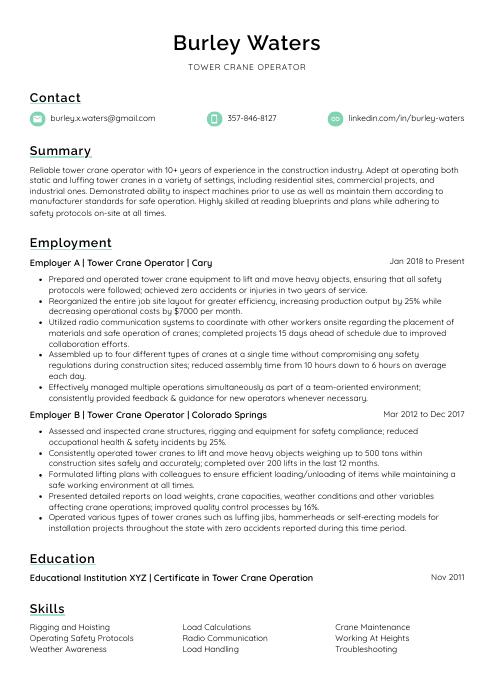 Lorikeet
Lorikeet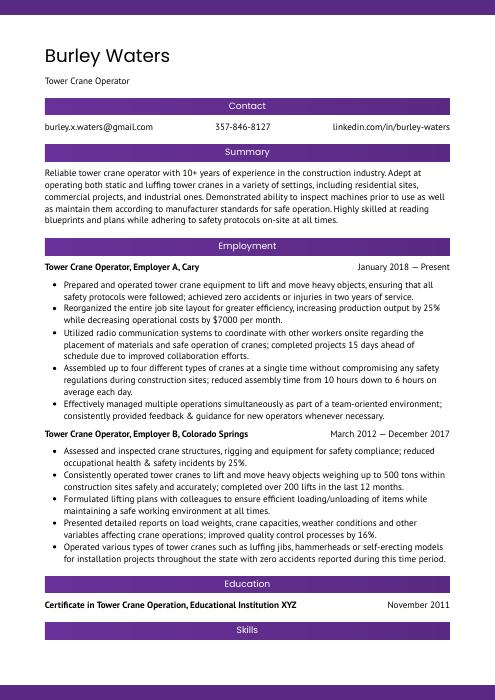 Jerboa
Jerboa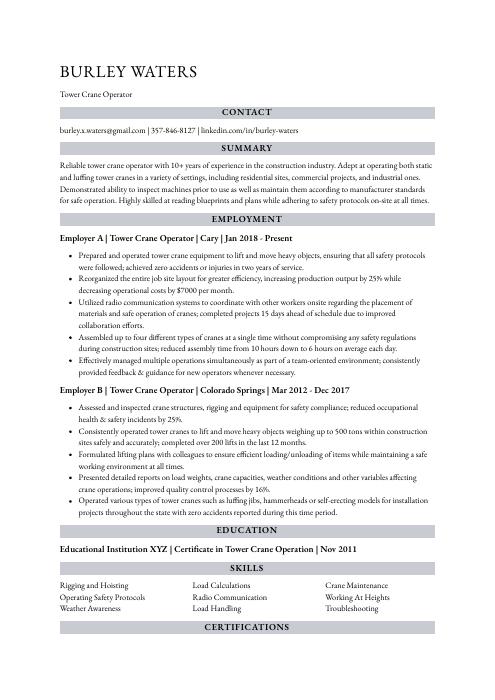 Numbat
Numbat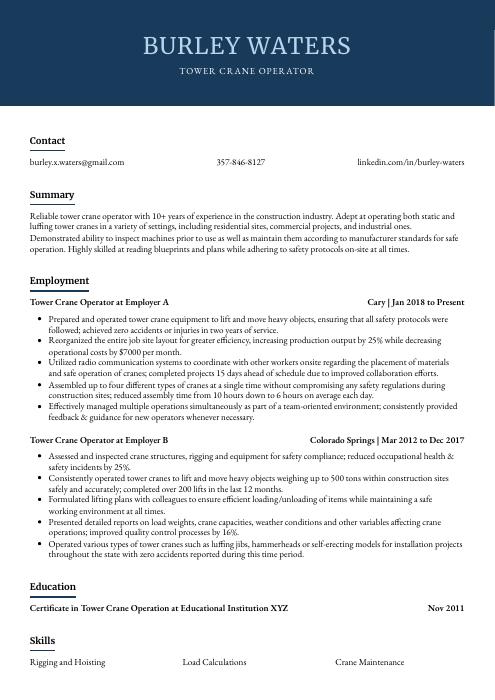 Bonobo
Bonobo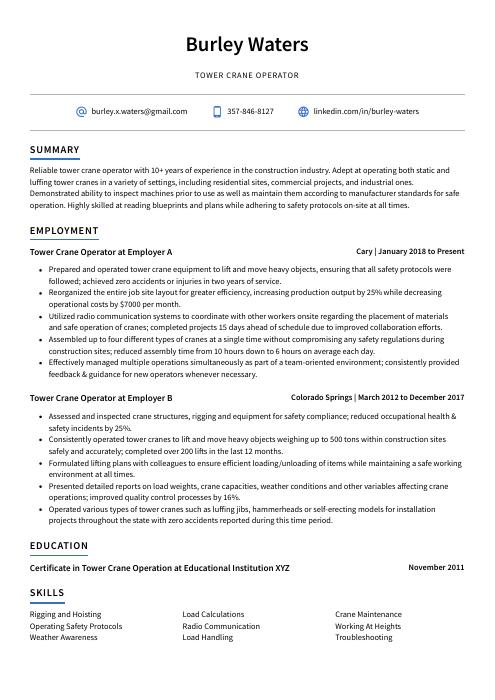 Axolotl
Axolotl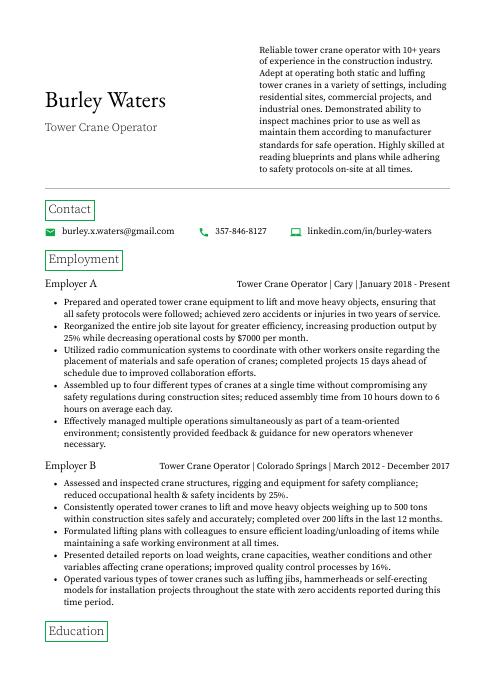 Quokka
Quokka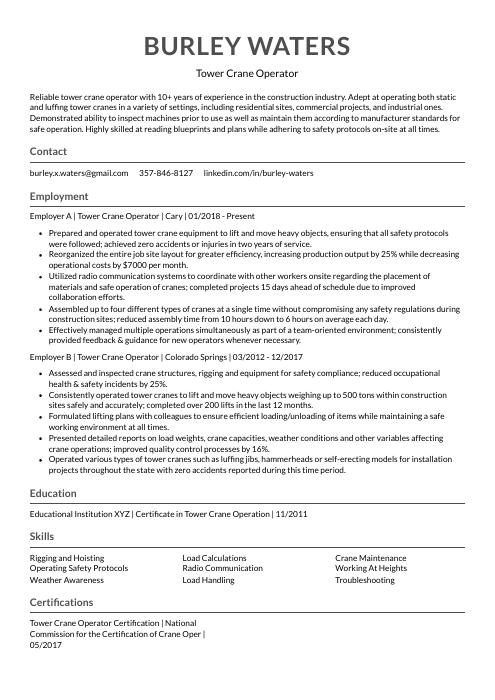 Indri
Indri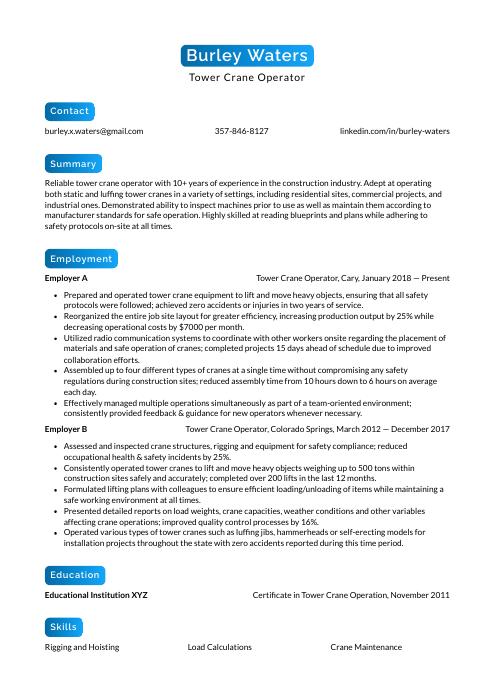 Kinkajou
Kinkajou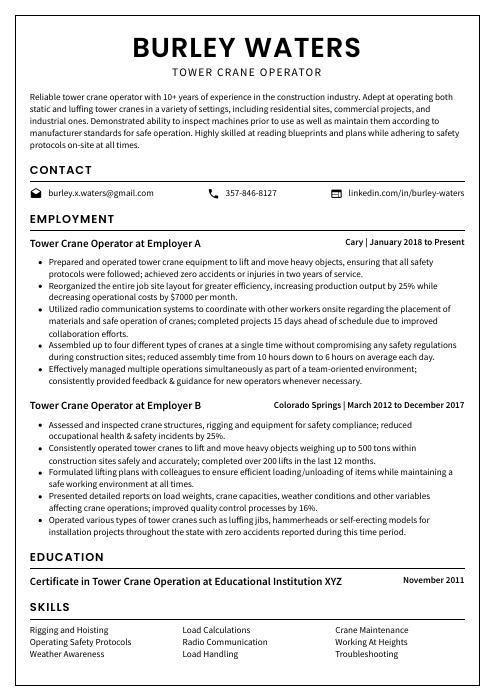 Cormorant
Cormorant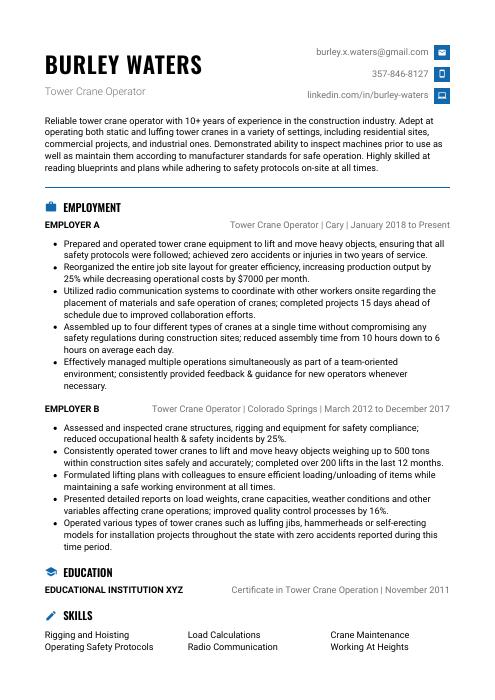 Echidna
Echidna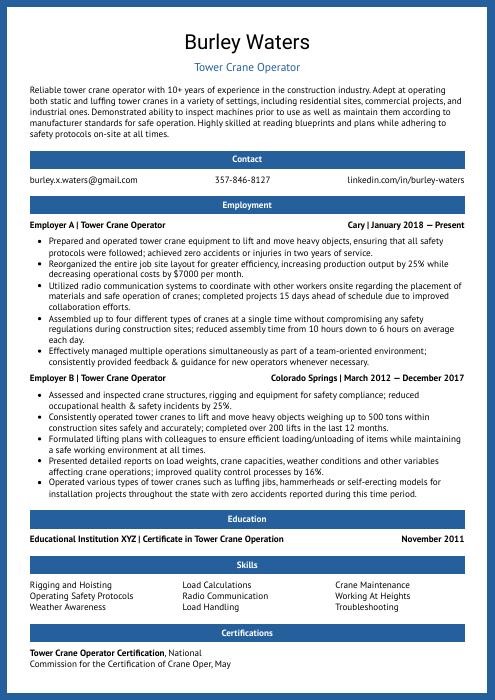 Ocelot
Ocelot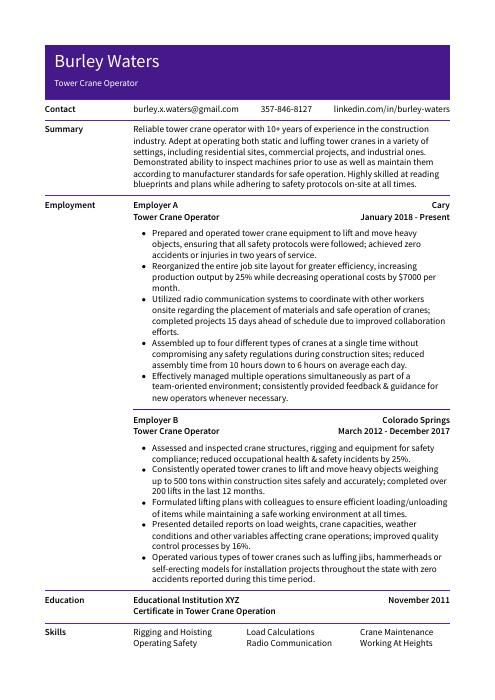 Pika
Pika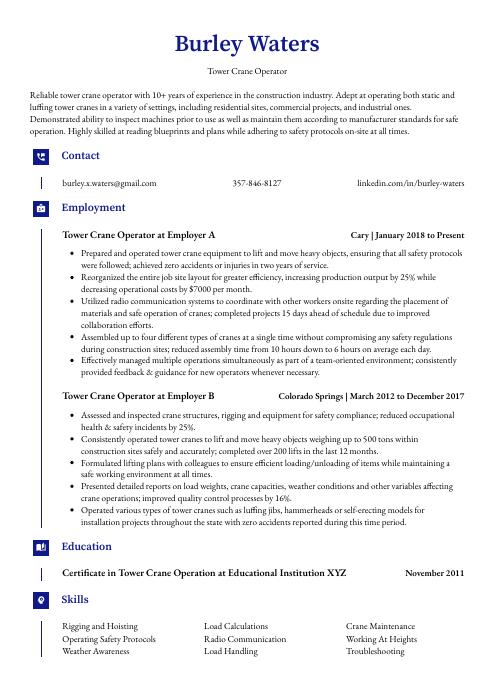 Gharial
Gharial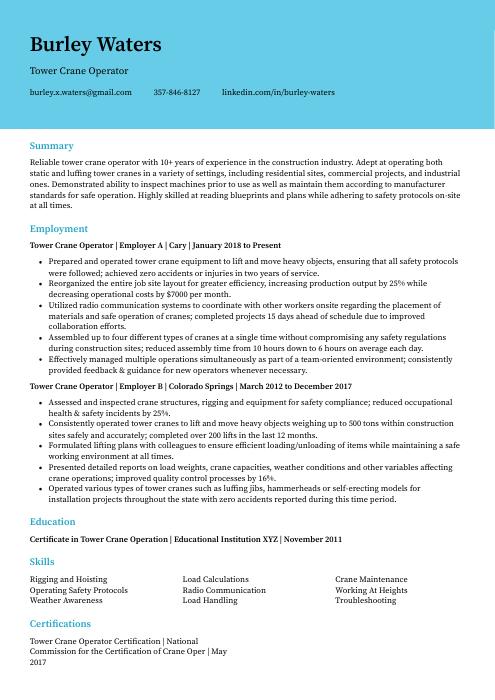 Dugong
Dugong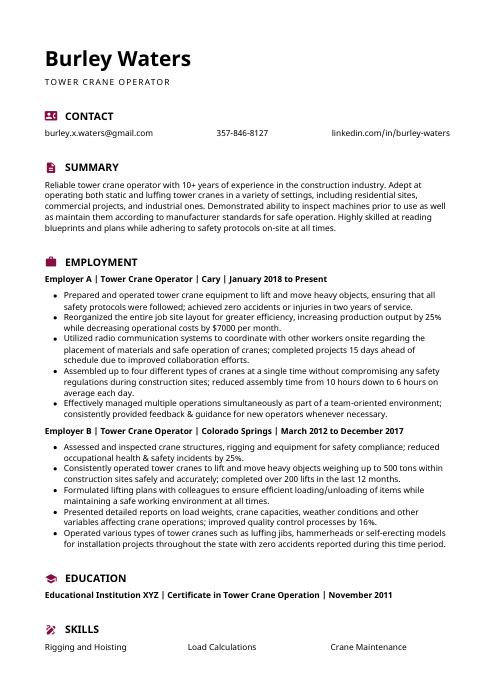 Hoopoe
Hoopoe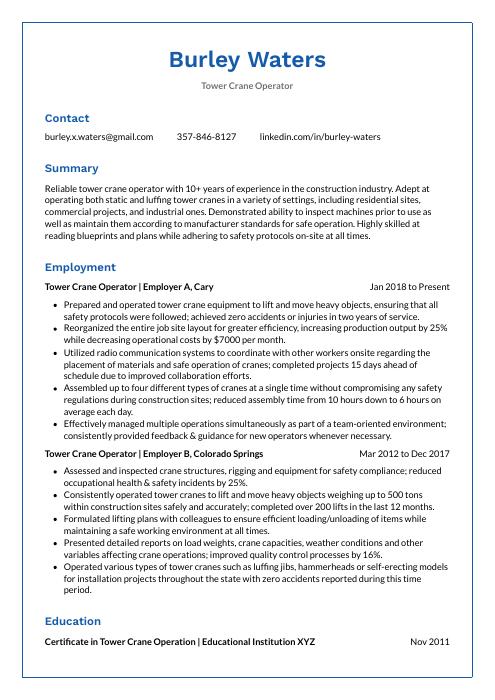 Markhor
Markhor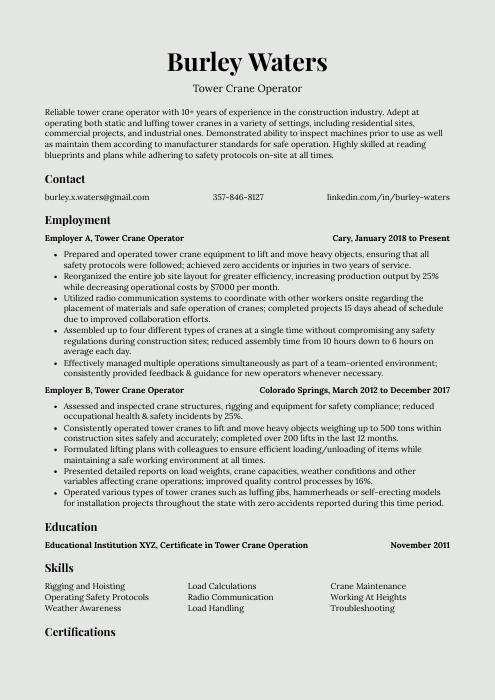 Saola
Saola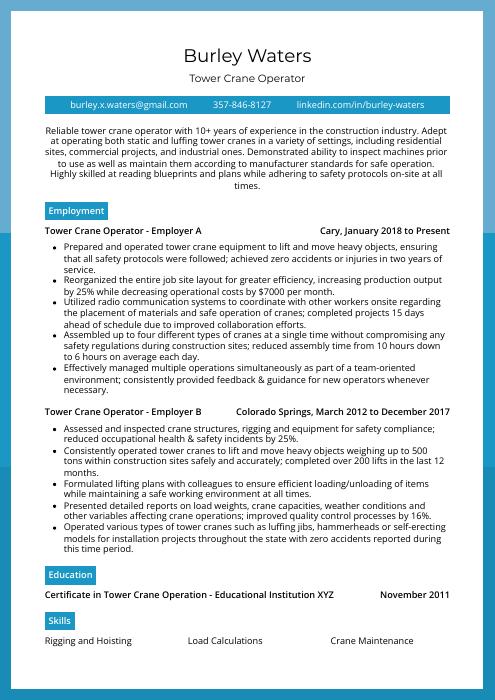 Rhea
Rhea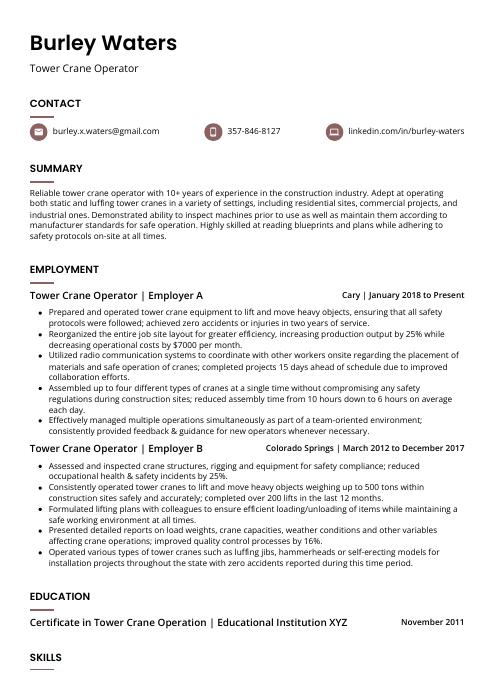 Fossa
Fossa Rezjumei
Rezjumei
